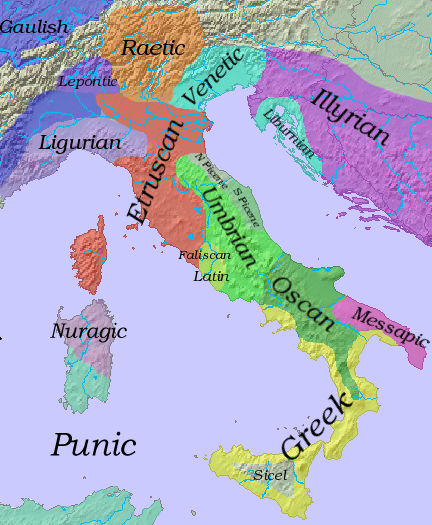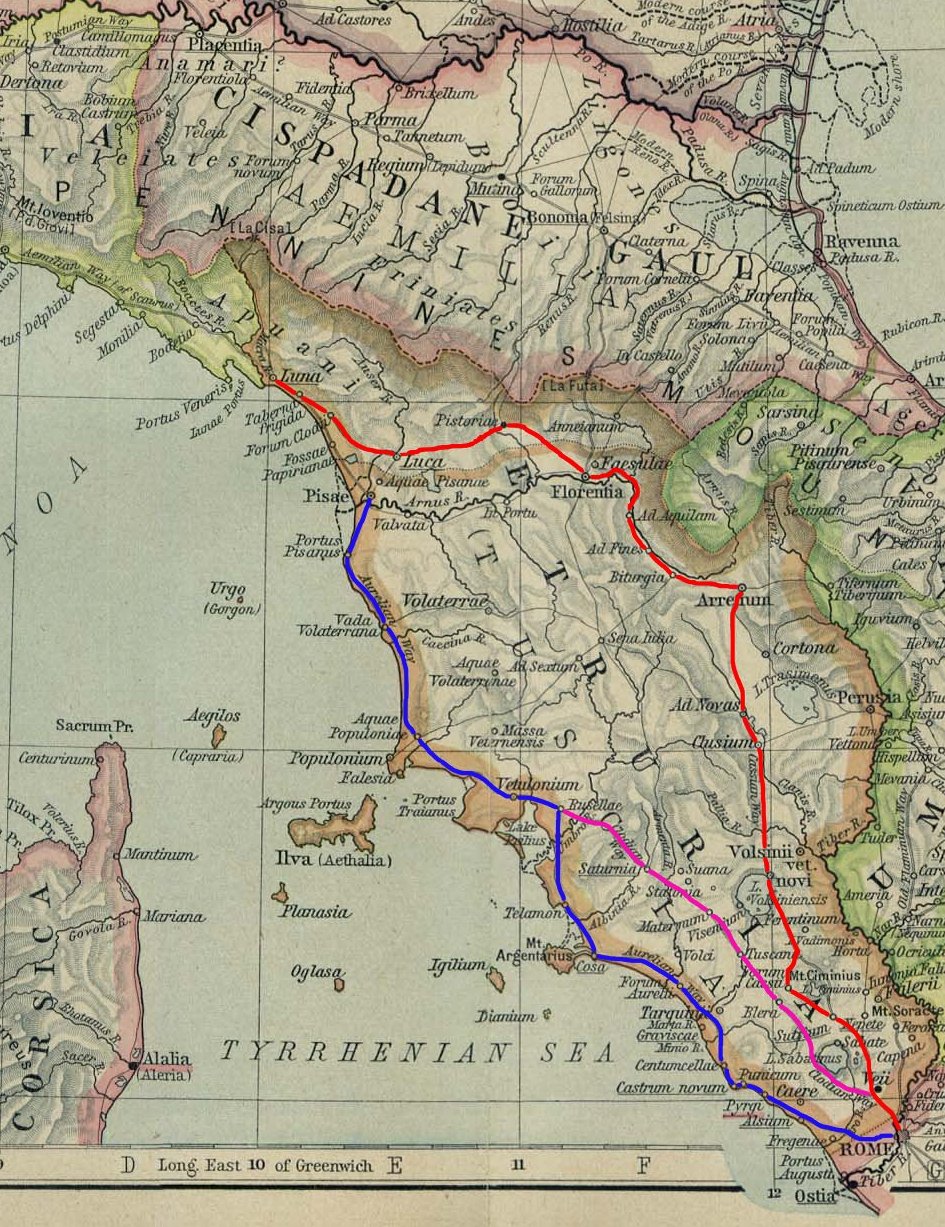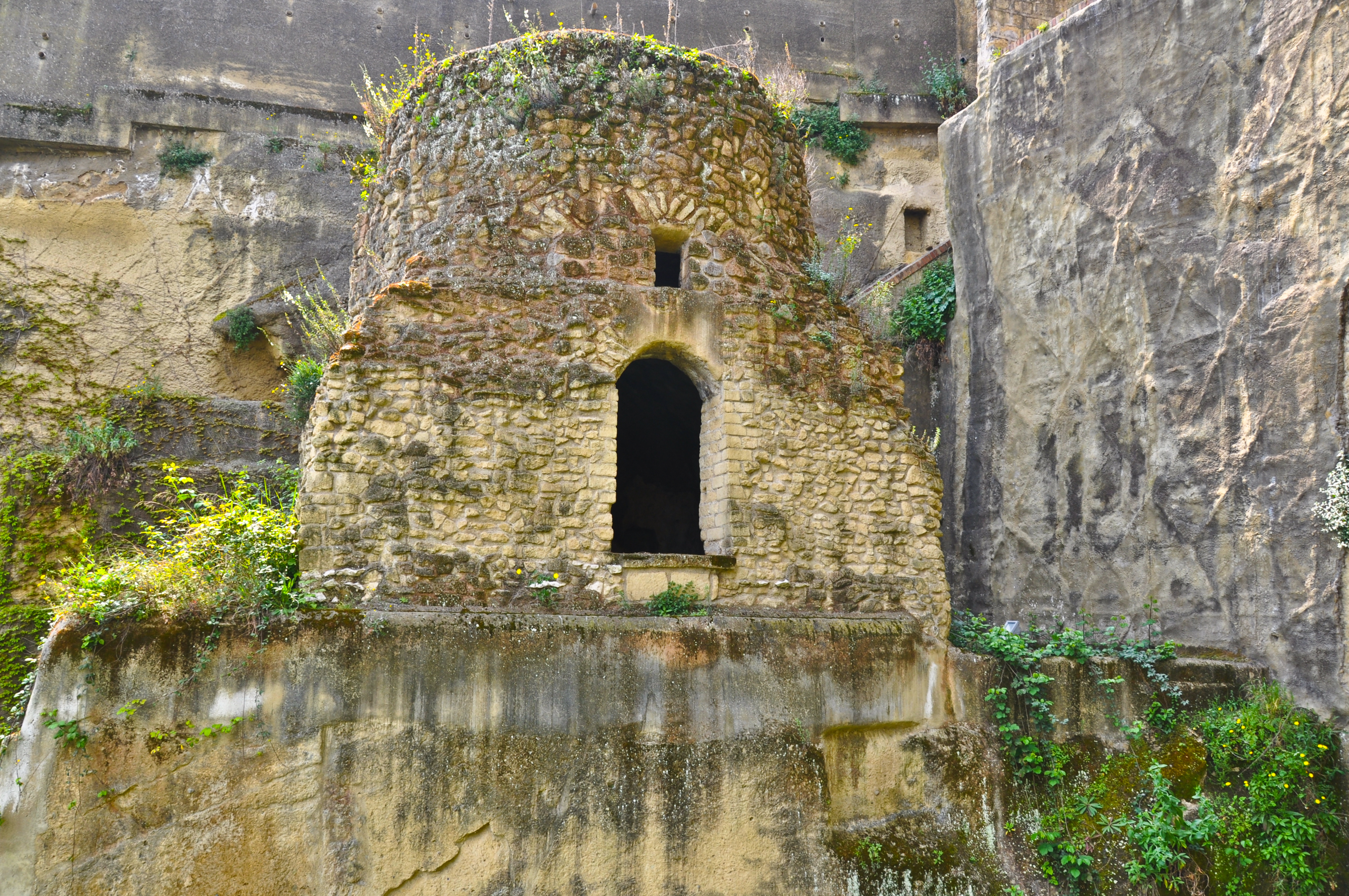|
Fescennia
Fescennia or Fescennium was an ancient city of Etruscan/ Faliscan origin, which is probably to be placed immediately to the north of the modern Corchiano, north west of Civita Castellana, in central Italy. The Via Amerina traverses it. At the Riserva S. Silvestro, walls exist. At Corchiano itself, however, similar walls may be traced, and the site is a strong and characteristic triangle between two deep ravines, with the third (west) side cut off by a ditch. Here, too, remains of two bridges may be seen, and several rich tombs have been excavated. The term '' Fescennine Verses'' refers to a certain kind of drinking song popular at festivals in ancient Rome and elsewhere. According to Festus, these songs were introduced from Fescennia, but others have thought that there is no reason to assume that any particular town was especially devoted to the use of such songs. Fescennia's warriors are also mentioned in Book VII of Virgil's Aeneid as following Messapus, the 'Steed Tamer' in ... [...More Info...] [...Related Items...] OR: [Wikipedia] [Google] [Baidu] |
Fescennine Verses
Fescennine Verses (Fescennina carmina), one of the earliest kinds of Italian poetry, subsequently developed into satire and Roman comic drama. History Originally sung at village harvest-home rejoicing, they made their way into the towns, and became the fashion at religious festivals and private gatherings, especially weddings, to which in later times they were practically restricted. They were usually in the Saturnine metre and took the form of a dialogue consisting of an interchange of extemporaneous raillery. Those who took part in them wore masks made of the bark of trees. At first harmless and good-humored, if somewhat coarse, these songs gradually outstripped the bounds of decency; malicious attacks were made upon both gods and men, and the matter became so serious that the law intervened and scurrilous personalities were forbidden by the Twelve Tables (Cicero, ''De re publica'', 4.10; see also Horace ''epist''. 2.1.139). Examples Specimens of the Fescennines used at weddings ... [...More Info...] [...Related Items...] OR: [Wikipedia] [Google] [Baidu] |
Falisci
The Falisci were an Italic peoples, Italic tribe who lived in what is now northern Lazio, on the Etruscan side of the Tiber River. They spoke an Italic languages, Italic language, Faliscan language, Faliscan, closely related to Latin. Originally a sovereign state, politically and socially they supported the Etruscan civilization, Etruscans, joining the Etruscan League. This conviction and affiliation led to their ultimate near destruction and total subjugation by Rome. Only one instance of their own endonym has been found to date: an inscription from Falerii Novi from the late 2nd century AD refers to the ', "the Faliscans who are in Sardinia", where ' is the nominative plural case. An Etruscan inscription calls them the '. The Latin cannot be far different from the original name. The -sc- suffix is "distinctive of the Italic ethnonyms". Geography The Falisci resided in a region called by the Romans the ', "Faliscan Country", located on the right bank of the Tiber River betwe ... [...More Info...] [...Related Items...] OR: [Wikipedia] [Google] [Baidu] |
Etruscan Civilization
The Etruscan civilization ( ) was an ancient civilization created by the Etruscans, a people who inhabited Etruria in List of ancient peoples of Italy, ancient Italy, with a common language and culture, and formed a federation of city-states. After adjacent lands had been conquered its territory covered, at its greatest extent, roughly what is now Tuscany, western Umbria and northern Lazio, as well as what are now the Po Valley, Emilia-Romagna, south-eastern Lombardy, southern Veneto and western Campania. A large body of literature has flourished on the origins of the Etruscans, but the consensus among modern scholars is that the Etruscans were an indigenous population. The earliest evidence of a culture that is identifiably Etruscan dates from about 900 BC. This is the period of the Iron Age Villanovan culture, considered to be the earliest phase of Etruscan civilization, which itself developed from the previous late Bronze Age Proto-Villanovan culture in the same region, p ... [...More Info...] [...Related Items...] OR: [Wikipedia] [Google] [Baidu] |
Corchiano
Corchiano is a town and ''comune ''in the province of Viterbo, Lazio, central Italy. It was an ancient settlement of the Faliscans and, in the Renaissance and later, a fief of the Farnese family. The local produce is hazelnuts and wine. Annual sagre include a live re-enactment of the birth of Jesus Jesus (AD 30 or 33), also referred to as Jesus Christ, Jesus of Nazareth, and many Names and titles of Jesus in the New Testament, other names and titles, was a 1st-century Jewish preacher and religious leader. He is the Jesus in Chris ... performed during Advent. In the summer, a park not far from the centre of the village stays open very late, and the town has several restaurants. References Cities and towns in Lazio Falisci Archaeological sites in Lazio {{Lazio-geo-stub ... [...More Info...] [...Related Items...] OR: [Wikipedia] [Google] [Baidu] |
Civita Castellana
Civita Castellana is a town and ''comune'' in the province of Viterbo, north of Rome. Mount Soracte lies about to the south-east. History Civita Castellana was settled during the Iron Age by the Italic Falisci, who called it " Falerii". After the Faliscan defeat by the Romans, the Romans built a new city, about away, " Falerii Novi." The abandoned city was repopulated beginning in the early Middle Ages, with the new name of Civita Castellana 'City of the Castle' first mentioned in 994. In the following centuries the city was a flourishing independent commune, often disputed between the Pope and the Holy Roman Empire. Captured by Pope Paschal II at the beginning of the 12th century, the city was given as a fief to the Savelli by Gregory XIV. Sixtus IV assigned the city to Cardinal Rodrigo Borgia, the future Pope Alexander VI, who started the construction of the Rocca ("Castle"), which was completed under Julius II. Civita Castellana became an important road hub with t ... [...More Info...] [...Related Items...] OR: [Wikipedia] [Google] [Baidu] |
Italy
Italy, officially the Italian Republic, is a country in Southern Europe, Southern and Western Europe, Western Europe. It consists of Italian Peninsula, a peninsula that extends into the Mediterranean Sea, with the Alps on its northern land border, as well as List of islands of Italy, nearly 800 islands, notably Sicily and Sardinia. Italy shares land borders with France to the west; Switzerland and Austria to the north; Slovenia to the east; and the two enclaves of Vatican City and San Marino. It is the List of European countries by area, tenth-largest country in Europe by area, covering , and the third-most populous member state of the European Union, with nearly 59 million inhabitants. Italy's capital and List of cities in Italy, largest city is Rome; other major cities include Milan, Naples, Turin, Palermo, Bologna, Florence, Genoa, and Venice. The history of Italy goes back to numerous List of ancient peoples of Italy, Italic peoples—notably including the ancient Romans, ... [...More Info...] [...Related Items...] OR: [Wikipedia] [Google] [Baidu] |
Via Amerina
The Via Cassia () was an important Roman road striking out of the Via Flaminia near the Milvian Bridge in the immediate vicinity of Rome and, passing not far from Veii, traversed Etruria. The ''Via Cassia'' passed through Baccanae, Sutrium, Volsinii, Clusium, Arretium, Florentia, Pistoria, and Luca, joining the Via Aurelia at Luna. The Via Cassia intersected other important roads. At mile 11 the Via Clodia diverged north-north-west. At Sette Vene, another road, probably the Via Annia, branched off to Falerii. In Sutrium, the ''Via Ciminia'' split off and later rejoined. The date of its construction is uncertain: it cannot have been earlier than 187 BC, when the consul Gaius Flaminius constructed a road from Bononia to Arretium, which must have coincided with a portion of the later Via Cassia. It is not mentioned by any ancient authorities before the time of Cicero, who in 45 BC speaks of the existence of three roads from Rome to Mutina: the Flaminia, the Aurelia ... [...More Info...] [...Related Items...] OR: [Wikipedia] [Google] [Baidu] |
Roman Festivals
Festivals in ancient Rome were a very important part of Roman religious life during both the Republican and Imperial eras, and one of the primary features of the Roman calendar. ''Feriae'' ("holidays" in the sense of "holy days"; singular also ''feriae'' or ''dies ferialis'') were either public ''(publicae)'' or private ''( privatae)''. State holidays were celebrated by the Roman people and received public funding. Games ''(ludi)'', such as the Ludi Apollinares, were not technically ''feriae'', but the days on which they were celebrated were '' dies festi'', holidays in the modern sense of days off work. Although ''feriae'' were paid for by the state, ''ludi'' were often funded by wealthy individuals. ''Feriae privatae'' were holidays celebrated in honor of private individuals or by families. This article deals only with public holidays, including rites celebrated by the state priests of Rome at temples, as well as celebrations by neighborhoods, families, and friends held ... [...More Info...] [...Related Items...] OR: [Wikipedia] [Google] [Baidu] |
Festus (historian)
Festus (died 3 January 380) was a Late Roman historian. His name appears in some manuscripts as Rufius Festus, Rufus Festus, Sextus Rufus or Sextus Festus, but they appear to be corruptions. He is mainly known as the author of an epitome titled ''Breviarium rerum gestarum populi Romani'' ("Summary of the accomplishments of the Romans"), written around AD 370 and commissioned by the Eastern emperor Valens in preparation for his war against Persia. The ''Breviarium'' covers the entire history of the Roman state from the foundation of the city. The book consists of 30 chapters treating Roman events in a terse overview, mainly focused on military and political conflicts. It is estimated to be a work of very low quality. He is often identified with Festus of Tridentum, ''magister memoriae'' (secretary) to Valens and notoriously severe proconsul of Asia, where he was sent to punish those implicated in the conspiracy of Theodorus. The work itself is divided into two parts, one geograp ... [...More Info...] [...Related Items...] OR: [Wikipedia] [Google] [Baidu] |
Virgil
Publius Vergilius Maro (; 15 October 70 BC21 September 19 BC), usually called Virgil or Vergil ( ) in English, was an ancient Rome, ancient Roman poet of the Augustan literature (ancient Rome), Augustan period. He composed three of the most famous poems in Latin literature: the ''Eclogues'' (or ''Bucolics''), the ''Georgics'', and the Epic poetry, epic ''Aeneid''. A number of minor poems, collected in the ''Appendix Vergiliana'', were attributed to him in ancient times, but modern scholars generally regard these works as spurious, with the possible exception of a few short pieces. Already acclaimed in his own lifetime as a classic author, Virgil rapidly replaced Ennius and other earlier authors as a standard school text, and stood as the most popular Latin poet through late antiquity, the Middle Ages, and early modernity, exerting inestimable influence on all subsequent Western literature. Geoffrey Chaucer assigned Virgil a uniquely prominent position among all the celebrities ... [...More Info...] [...Related Items...] OR: [Wikipedia] [Google] [Baidu] |
Aeneid
The ''Aeneid'' ( ; or ) is a Latin Epic poetry, epic poem that tells the legendary story of Aeneas, a Troy, Trojan who fled the Trojan War#Sack of Troy, fall of Troy and travelled to Italy, where he became the ancestor of the Ancient Rome, Romans. Written by the Roman poet Virgil between 29 and 19 BC, the ''Aeneid'' comprises 9,896 lines in dactylic hexameter. The first six of the poem's twelve books tell the story of Aeneas' wanderings from Troy to Italy, and the poem's second half tells of the Trojans' ultimately victorious war upon the Latins (Italic tribe), Latins, under whose name Aeneas and his Trojan followers are destined to be subsumed. The hero Aeneas was already known to Greco-Roman legend and myth, having been a character in the ''Iliad''. Virgil took the disconnected tales of Aeneas' wanderings, his vague association with the foundation of Ancient Rome, Rome and his description as a personage of no fixed characteristics other than a scrupulous ''pietas'', ... [...More Info...] [...Related Items...] OR: [Wikipedia] [Google] [Baidu] |
Messapus
Messapus, (Greek language, Greek: Μέσσαπος, ''Messapos'') a character in Virgil's ''Aeneid'', appears in Books VII to XII of the Latin Epic poetry, epic poem. He was a son of Neptune (mythology), Neptune, a famous tamer of horses, and king of Etruria, known for being one "whom no one can fell by fire or steel" (Mandelbaum, VII.911-912). Narrative Although accustomed to peace, in Book VII Messapus joins forces with Turnus in his battle against Aeneas and the Troy, Trojans. Book VIII lists him as one of Turnus' chief captains, along with Ufens and Mezentius. In Book IX, which recounts the nighttime raid by Nisus and Euryalus on the Rutulian camp, the battle helmet of Messapus is taken by Nisus and Euryalus, Euryalus. Light reflected off the stolen helmet, betraying Nisus and Euryalus, Euryalus to his enemies and leading not only to his own death, but also that of Nisus and Euryalus, Nisus. Messapus fought in battle in Book X, killing Clonius, and Ericetes son of Lycaon (G ... [...More Info...] [...Related Items...] OR: [Wikipedia] [Google] [Baidu] |






